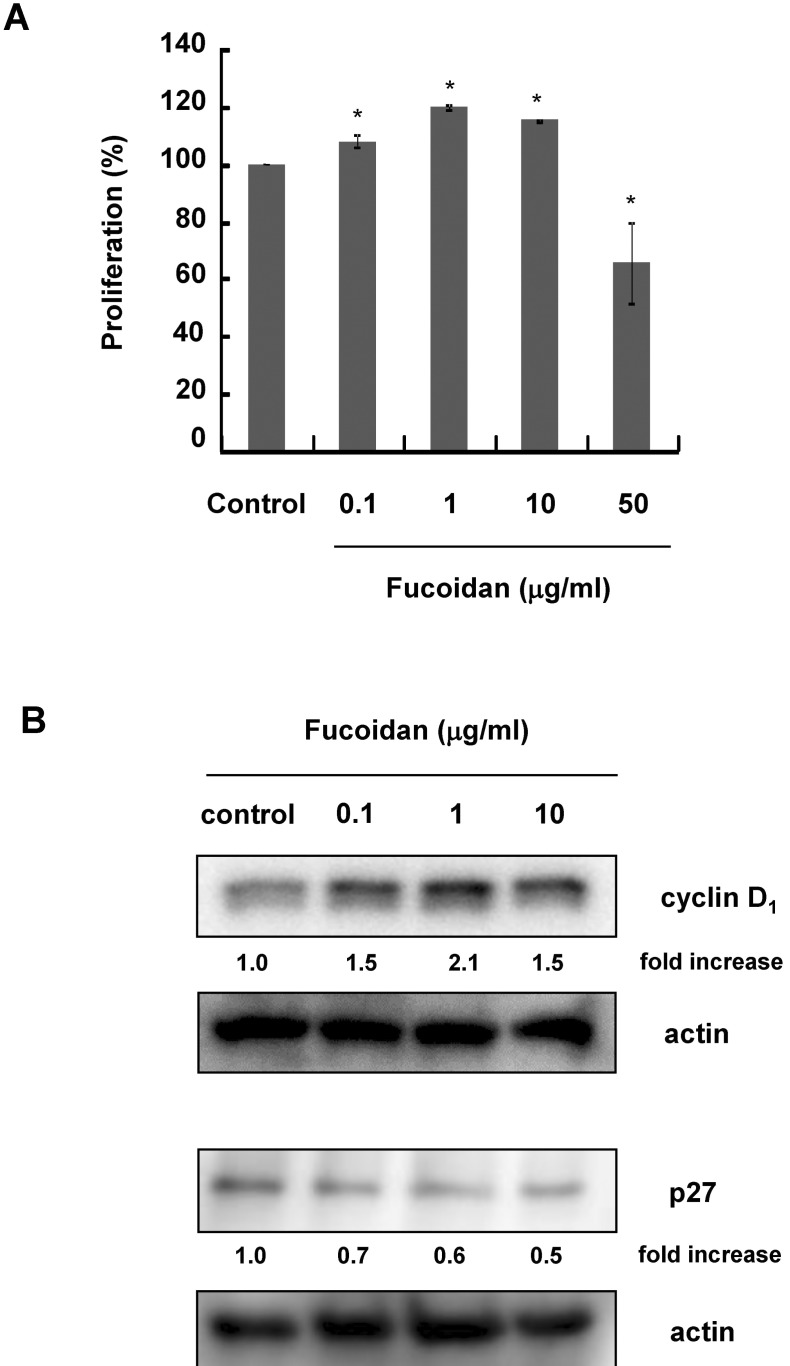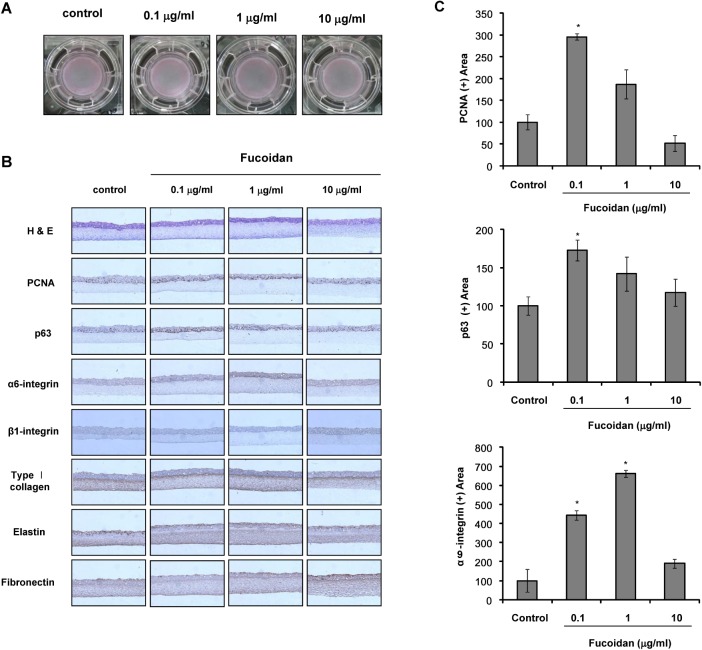Korean J Physiol Pharmacol.
2014 Aug;18(4):327-331. 10.4196/kjpp.2014.18.4.327.
Fucoidan Promotes the Reconstruction of Skin Equivalents
- Affiliations
-
- 1Department of Biochemistry, Chung-Ang University College of Medicine, Seoul 156-756, Korea. ds_kim@cau.ac.kr
- 2Department of Dermatology, Seoul National University Bundang Hospital, Seongnam 463-707, Korea.
- KMID: 2285527
- DOI: http://doi.org/10.4196/kjpp.2014.18.4.327
Abstract
- In this study we investigated the effects of fucoidan on the proliferation of fibroblasts and the reconstruction of a skin equivalent (SE). Fucoidan significantly stimulated the proliferation of CCD-25Sk human fibroblasts and Western blot analysis demonstrated that fucoidan markedly increased the expression of cyclin D1 and decreased the expression of p27. Fucoidan was used to reconstruct SE. Immunohistochemical staining showed that the addition of fucoidan to dermal equivalents increased expression of proliferating cell nuclear antigen (PCNA) and p63. In addition, expression of alpha6-integrin was significantly increased by fucoidan, whereas expression of beta1-integrin, type 1 collagen, elastin, fibronectin did not markedly change. These results suggest that fucoidan has positive effects on epidermal reconstruction and will therefore be beneficial in the reconstruction of SE.
Keyword
MeSH Terms
Figure
Cited by 1 articles
-
ERK Activation by Fucoidan Leads to Inhibition of Melanogenesis in Mel-Ab Cells
Yu Seok Song, Marie Carmel Balcos, Hye-Young Yun, Kwang Jin Baek, Nyoun Soo Kwon, Myo-Kyoung Kim, Dong-Seok Kim
Korean J Physiol Pharmacol. 2015;19(1):29-34. doi: 10.4196/kjpp.2015.19.1.29.
Reference
-
1. Régnier M, Asselineau D, Lenoir MC. Human epidermis reconstructed on dermal substrates in vitro: an alternative to animals in skin pharmacology. Skin Pharmacol. 1990; 3:70–85. PMID: 2078346.
Article2. Augustin C, Damour O. Pharmacotoxicological applications of an equivalent dermis: three measurements of cytotoxicity. Cell Biol Toxicol. 1995; 11:167–171. PMID: 8564646.
Article3. Senthilkumar K, Manivasagan P, Venkatesan J, Kim SK. Brown seaweed fucoidan: biological activity and apoptosis, growth signaling mechanism in cancer. Int J Biol Macromol. 2013; 60:366–374. PMID: 23817097.
Article4. Ko EJ, Joo HG. Fucoidan enhances the survival and sustains the number of splenic dendritic cells in mouse endotoxemia. Korean J Physiol Pharmacol. 2011; 15:89–94. PMID: 21660148.
Article5. Zhu Z, Zhang Q, Chen L, Ren S, Xu P, Tang Y, Luo D. Higher specificity of the activity of low molecular weight fucoidan for thrombin-induced platelet aggregation. Thromb Res. 2010; 125:419–426. PMID: 20381830.
Article6. Ale MT, Maruyama H, Tamauchi H, Mikkelsen JD, Meyer AS. Fucoidan from Sargassum sp. and Fucus vesiculosus reduces cell viability of lung carcinoma and melanoma cells in vitro and activates natural killer cells in mice in vivo. Int J Biol Macromol. 2011; 49:331–336. PMID: 21624396.7. Lee SH, Ko CI, Jee Y, Jeong Y, Kim M, Kim JS, Jeon YJ. Anti-inflammatory effect of fucoidan extracted from Ecklonia cava in zebrafish model. Carbohydr Polym. 2013; 92:84–89. PMID: 23218269.
Article8. Hayashi K, Lee JB, Nakano T, Hayashi T. Anti-influenza A virus characteristics of a fucoidan from sporophyll of Undaria pinnatifida in mice with normal and compromised immunity. Microbes Infect. 2013; 15:302–309. PMID: 23376164.
Article9. Wang J, Zhang Q, Zhang Z, Song H, Li P. Potential antioxidant and anticoagulant capacity of low molecular weight fucoidan fractions extracted from Laminaria japonica. Int J Biol Macromol. 2010; 46:6–12. PMID: 19883681.
Article10. Moon HJ, Lee SH, Ku MJ, Yu BC, Jeon MJ, Jeong SH, Stonik VA, Zvyagintseva TN, Ermakova SP, Lee YH. Fucoidan inhibits UVB-induced MMP-1 promoter expression and down regulation of type I procollagen synthesis in human skin fibroblasts. Eur J Dermatol. 2009; 19:129–134. PMID: 19129083.11. O'Leary R, Rerek M, Wood EJ. Fucoidan modulates the effect of transforming growth factor (TGF)-beta1 on fibroblast proliferation and wound repopulation in in vitro models of dermal wound repair. Biol Pharm Bull. 2004; 27:266–270. PMID: 14758050.12. Mezzano V, Cabrera D, Vial C, Brandan E. Constitutively activated dystrophic muscle fibroblasts show a paradoxical response to TGF-beta and CTGF/CCN2. J Cell Commun Signal. 2007; 1:205–217. PMID: 18600480.13. Cho YS, Lee KH, Park JW. Pyrithione-zinc Prevents UVB-induced Epidermal Hyperplasia by Inducing HIF-1alpha. Korean J Physiol Pharmacol. 2010; 14:91–97. PMID: 20473380.14. Prietzsch H, Brock J, Kleine HD, Liebe S, Jaster R. Interferon-alpha inhibits cell cycle progression by Ba/F3 cells through the antagonisation of interleukin-3 effects on key regulators of G(1)/S transition. Cell Signal. 2002; 14:751–759. PMID: 12034356.
Article15. Blagosklonny MV, Pardee AB. The restriction point of the cell cycle. Cell Cycle. 2002; 1:103–110. PMID: 12429916.
Article16. Tang PP, Hsieh SC, Wang FF. Modulation of caspase activation and p27(Kip1) degradation in the p53-induced apoptosis in IW32 erythroleukemia cells. Cell Signal. 2002; 14:961–968. PMID: 12220622.
Article17. Liu Y, Wu J, Ho PY, Chen LC, Chen CT, Liang YC, Cheng CK, Lee WS. Anti-angiogenic action of 5,5-diphenyl-2-thiohydantoin-N10 (DPTH-N10). Cancer Lett. 2008; 271:294–305. PMID: 18649995.
Article18. Boukamp P, Petrussevska RT, Breitkreutz D, Hornung J, Markham A, Fusenig NE. Normal keratinization in a spontaneously immortalized aneuploid human keratinocyte cell line. J Cell Biol. 1988; 106:761–771. PMID: 2450098.
Article19. Jeong YM, Lee JE, Kim SY, Yun HY, Baek KJ, Kwon NS, Kim DS. Enhanced effects of citrate on UVB-induced apoptosis of B16 melanoma cells. Pharmazie. 2009; 64:829–833. PMID: 20095142.20. Bell E, Ivarsson B, Merrill C. Production of a tissue-like structure by contraction of collagen lattices by human fibroblasts of different proliferative potential in vitro. Proc Natl Acad Sci U S A. 1979; 76:1274–1278. PMID: 286310.
Article21. Auger FA, López Valle CA, Guignard R, Tremblay N, Noël B, Goulet F, Germain L. Skin equivalent produced with human collagen. In Vitro Cell Dev Biol Anim. 1995; 31:432–439. PMID: 8589886.
Article22. Nobre LT, Vidal AA, Almeida-Lima J, Oliveira RM, Paredes-Gamero EJ, Medeiros VP, Trindade ES, Franco CR, Nader HB, Rocha HA. Fucan effect on CHO cell proliferation and migration. Carbohydr Polym. 2013; 98:224–232. PMID: 23987339.
Article23. Terada M, Inaba M, Yano Y, Hasuma T, Nishizawa Y, Morii H, Otani S. Growth-inhibitory effect of a high glucose concentration on osteoblast-like cells. Bone. 1998; 22:17–23. PMID: 9437509.
Article24. Chung JH, Han JH, Hwang EJ, Seo JY, Cho KH, Kim KH, Youn JI, Eun HC. Dual mechanisms of green tea extract (EGCG)-induced cell survival in human epidermal keratinocytes. FASEB J. 2003; 17:1913–1915. PMID: 12897059.25. Blanpain C, Fuchs E. p63: revving up epithelial stem-cell potential. Nat Cell Biol. 2007; 9:731–733. PMID: 17603506.
Article26. Truong AB, Kretz M, Ridky TW, Kimmel R, Khavari PA. p63 regulates proliferation and differentiation of developmentally mature keratinocytes. Genes Dev. 2006; 20:3185–3197. PMID: 17114587.
Article27. Wha Kim S, Lee IW, Cho HJ, Cho KH, Han Kim K, Chung JH, Song PI, Chan Park K. Fibroblasts and ascorbate regulate epidermalization in reconstructed human epidermis. J Dermatol Sci. 2002; 30:215–223. PMID: 12443844.
Article28. Sonnenberg A, Calafat J, Janssen H, Daams H, van der Raaij-Helmer LM, Falcioni R, Kennel SJ, Aplin JD, Baker J, Loizidou M, et al. Integrin alpha 6/beta 4 complex is located in hemidesmosomes, suggesting a major role in epidermal cell-basement membrane adhesion. J Cell Biol. 1991; 113:907–917. PMID: 2026654.
Article
- Full Text Links
- Actions
-
Cited
- CITED
-
- Close
- Share
- Similar articles
-
- Fucoidan Enhances the Survival and Sustains the Number of Splenic Dendritic Cells in Mouse Endotoxemia
- Anti-inflammatory Activity of Fucoidan with Blocking NF-kappaB and STAT1 in Human Keratinocytes Cells
- Antimetastatic effect of fucoidan against non-small cell lung cancer by suppressing non-receptor tyrosine kinase and extracellular signalrelated kinase pathway
- Biological effects of fucoidan isolated from Fucus vesiculosus on thrombosis and vascular cells
- Fucoidan Induces Apoptosis in A2058 Cells through ROS-exposed Activation of MAPKs Signaling Pathway



